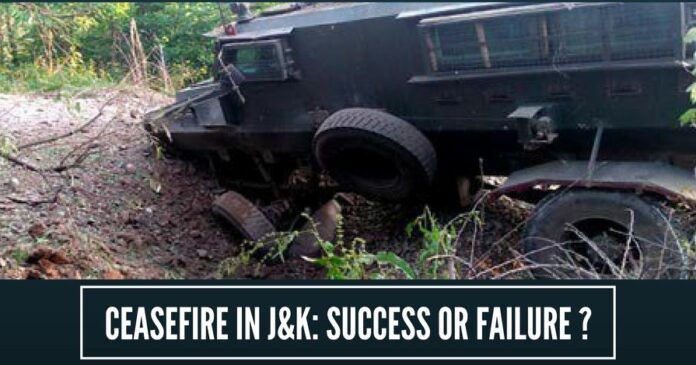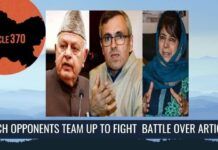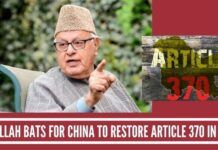
Under these circumstances, the decision to announce ceasefire was welcomed and hailed as a ‘bold’ decision of the Indian government.
By agreeing to the demand of the J&K Chief Minister Mehbooba Mufti to announce ceasefire during the holy month of Ramzan the Government of India had taken a calculated risk of closely watching the ground situation for some time and determine which way the wind is blowing on ground zero.
The situation along the line of control and the International border also remain equally tense in view of regular exchange of firing.
Now after patiently waiting for first 10 days of Ramzan, the army authorities have concluded that the situation is gradually going from bad to worse.
In the small period, the terrorist organisations have carried out more lethal strikes targeting jawans of the Indian army.
In the process, they also exhibited the range of their striking capacity and innovative methods adopted before targeting jawans of the security forces.
As per the recent assessment of security forces, the jawans of the Indian army continue to remain at the receiving end of the propaganda machinery used by vested interests to denigrate their presence in the region.
If nature of incidents reported across Kashmir valley are any indication. It is certain the security forces heading for more troubled times ahead in the run-up to the annual Amarnath pilgrimage.
Already incidents of weapon snatching, IED blast, ambush of soldiers, attack on convoy vehicles have been reported in the area in the last 10 days. There was no let up from the Pakistani side to infiltrate heavily armed militants inside the Indian Territory.
The situation along the line of control and the International border also remain equally tense in view of regular exchange of firing.
In the latest incident of a strike on army jawans, a CASPER vehicle came under attack by the militants on Monday in Zainapora area of Shopian. Three soldiers including an officer were injured while the bulletproof vehicle was severely damaged in the blast.
An IED was used to trigger a powerful blast in the middle of the road.
The incident clearly signalled that if the govt would not agree to their terms and conditions of extending the ceasefire agreement similar strikes would be launched.
In some cases the youth also pelted stones and disrupted the movement of the Indian army and facilitated easy movement of holed up militants from the encounter site
In addition, the manner in which fresh incidents of targeting informers and killing them in cold blood in front of their loved ones have come to light it only reflects the hardcore training these militant cadres have undergone before joining the ranks of terrorist outfits.
Who pushed the agenda of ceasefire and why?
Initially, army authorities were not on board but when their serious concerns were addressed at the highest level in the union government the ceasefire was announced with a rider that the Indian army would not initiate operations on its own but if fired upon they would hit back.
As the announcement came close on the heels of ‘operation all out‘ launched by the Indian army many eyebrows were raised and the corridors of power and in the security establishment.
Since army had achieved major successes by eliminating a majority of local militant leadership in clinical strikes in the densely populated areas of South Kashmir and parts of North Kashmir security experts warned against the move.
They wanted the Indian army to maintain its supremacy over militant commanders and not give them an opportunity to regroup and refurbish to launch more lethal strikes on the security apparatus. But a section of the political establishment in the state and in the centre prevailed and convinced the decision makers at the top to test the waters in Kashmir valley.
Initial assessment clearly suggested the union government may have won hearts of Kashmiri residents but compromised the security of our armed forces.
While these operations were on hatred against the Indian armed forces also came to the fore.
During the same time, the Indian army also intensified its cordon and search operations (CASO) to track down the footprints of local militant commanders.
As joint teams of security forces went on to eliminate key commanders large crowds started turning up during funeral processions of these militant commanders.
Sensing more trouble the security forces set the alarm bells ringing and called for more result oriented operations. As more and more youth were getting radicalised across Kashmir valley the army authorities had to review their strategy on ground zero and they also started offering militants the option to lay down their arms and even organised direct chats between militants and their families to win them back into the mainstream.
As part of their counter strategy, separatist leaders in the valley tried to channelise people’s anger against the security forces and mobilised a large number of youth to disrupt anti-terrorist operations in the hinterland.
In some cases, the youth also pelted stones and disrupted the movement of the Indian army and facilitated easy movement of holed up militants from the encounter site.
Under these circumstances, the decision to announce ceasefire was welcomed and hailed as a ‘bold‘ decision of the Indian government taken at the highest level in view of the prevailing political situation in the state.
Note:
1. The views expressed here are those of the author and do not necessarily represent or reflect the views of PGurus.
- Assembly polls in Jammu and Kashmir soon: Modi - April 12, 2024
- Campaign trail: Udhampur-Doda Lok Sabha seat - April 8, 2024
- Ghulam Nabi Azad returns to the poll arena, to contest the Anantnag-Rajouri Lok Sabha seat - April 2, 2024











Ceasfire with Pakistan is a joke. BJP Govt has committed blunder. The counter offensive against Pakistan should continue & weave maximum damage on Pakistan